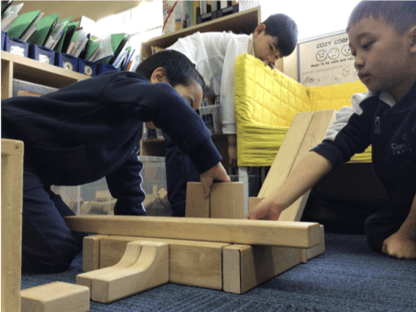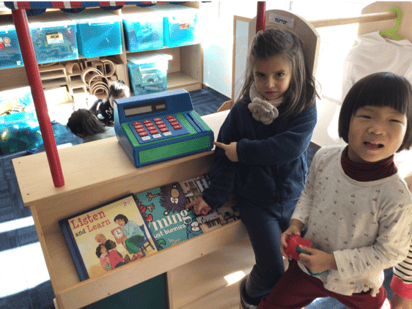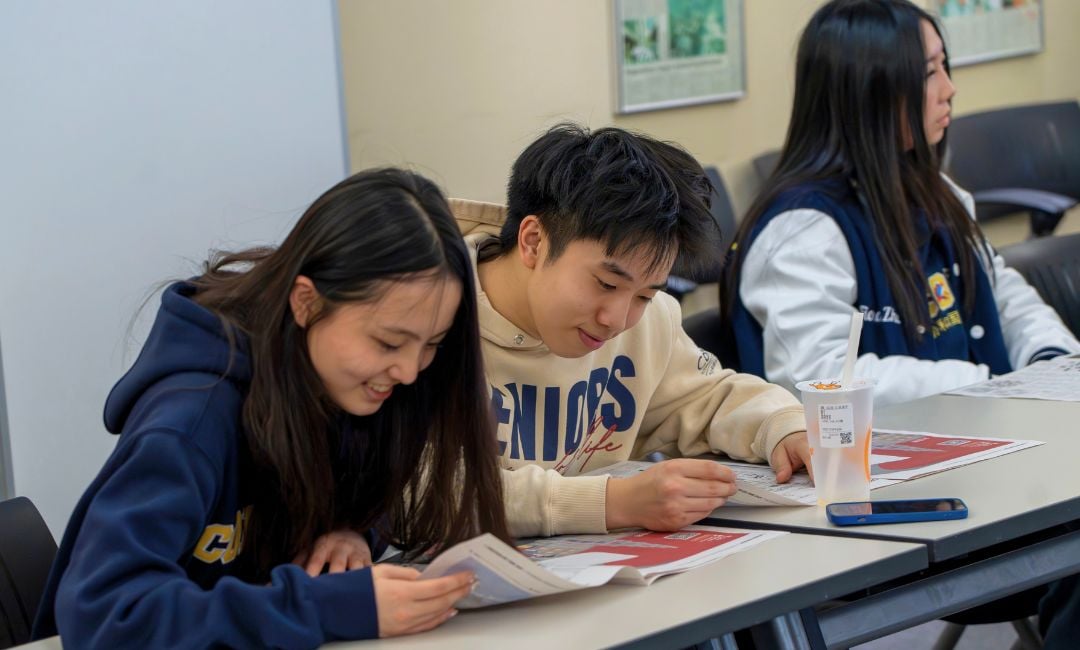When is it appropriate for adults to insert themselves in play? Isn’t play time an opportunity for children to explore their own curiosities and inquiries? These are two of the most frequent and important questions I hear from teachers and parents alike at Concordia Shanghai.
While some might disagree with adults interrupting a child’s playtime, there are beneficial ways and other ways that may not be helpful. In this article, we will explore 3 steps to craft meaningful play conversations that will positively impact children’s language.
Step One: Watch and Listen
Initially, when children play, our first responsibility is to listen. Not just hear—but really listen to what the children are doing, saying, and feeling. An example of this can be found in the following scenario.
 Classroom scenario:
Classroom scenario:
A group of kindergarten students are playing with blocks in a classroom. During this time, one of the students gets visibly upset with the other two. He is not saying anything about his feelings, but they are “written” all over his face. The teacher, who had been listening all the while, inserts herself in their play quickly and purposefully. There is soon a back-and-forth discussion about inclusion of others and their ideas.
In this situation, had the teacher come over and demanded to know what was going on, the student with the problem would most likely have said nothing or began to cry. However, because the teacher listened first, the real root of the problem was dealt with, and all of the students involved learned from the event.
This might seem like a small thing, but all of what we could teach students hinges on what they already know. When we enter their play in a demanding way, students become reticent to share. Upon careful listening, we can really uncover what students already know and are capable of. That is the holy grail of teaching — finding what students know and can do. Once this is done, the work of adding to this base of knowledge is productive.
Step Two: Use What You've Learned
The second step is to use what you’ve learned from listening. Below I have included an example of how one Concordia teacher was able to do this with a group of her own students.
Classroom Scenario:
 A small group of Pre-K students are making a bookstore by “selling” the library books they had taken from the school library for the week. As the teacher listens to them play, she soon finds out they have an inflated sense of what the value was for each book “purchase.” Instead of telling them how much the books cost, and helping them label each book with the correct price, she helps the students quickly research the cost of books in China so they can decide for themselves how much each of the books are worth.
A small group of Pre-K students are making a bookstore by “selling” the library books they had taken from the school library for the week. As the teacher listens to them play, she soon finds out they have an inflated sense of what the value was for each book “purchase.” Instead of telling them how much the books cost, and helping them label each book with the correct price, she helps the students quickly research the cost of books in China so they can decide for themselves how much each of the books are worth.
Through this deeper discussion, the teacher showed students how to begin the process of research and the importance of using that research to make decisions. Again, this may seem like a small thing, but the students really had to work to figure out what to do. The conversation that happened about price ranges, sales techniques, monetary values, and a myriad of other concepts created the depth of language and success for this activity. It had little to do with the information the teacher provided, and much to do with the discussion about real-world concepts. This brings us to the final piece of the play puzzle.
Step Three: Create Connections
What happens now that students are playing at a deeper level? The third step is simply this: connection. Many researchers agree (Samuelsson & Carlsson, 2008; Zosh, Hopkins, et al., 2017) that creating connections between what students already know, and new related information or skills is vital in creating long-term learning. However, these same experts also agree that creating connections from the student to the world in which they live is also essential. Whether this looks like connecting a toy dinosaur to what is written in a non-fiction book or researching how toy trains connect and repel each other to explain concepts of magnetism, the real world plays an enormous part in a child’s understanding of concepts to be learned. By using real-world concepts to explain the next step in what the child already knows and can do, we as parents and educators can more effectively impact the learning and language of our youngest learners.
Morgen Malnack
MEd, Early Childhood Education
EC ELL Specialist at Concordia Shanghai




